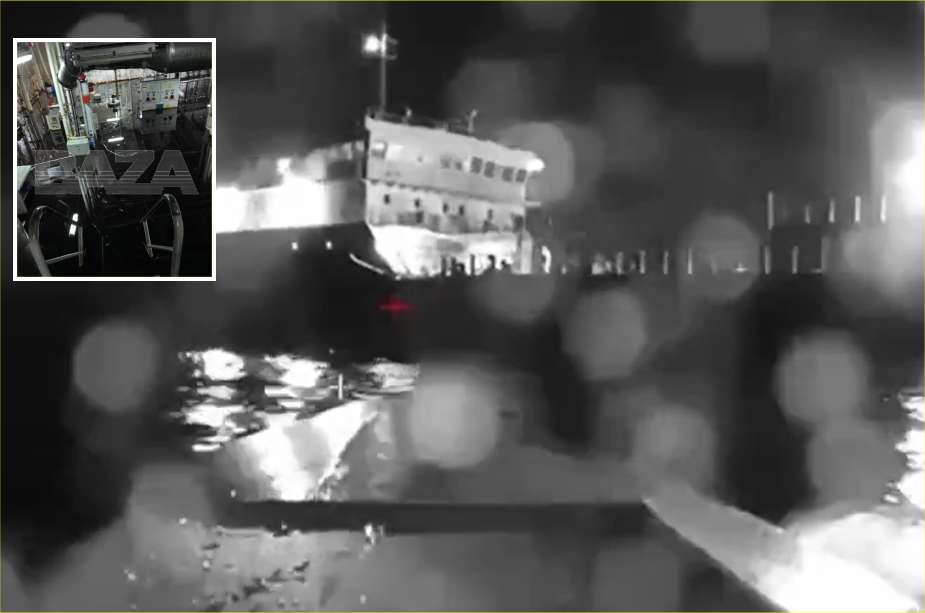Breaking news
Ukrainian naval drone strikes Russian oil tanker off the coast of Crimea.
According to a tweet from Tendar on August 5, 2023, a Russian oil tanker named "Sig" was struck by a Ukrainian naval drone in the Kerch Strait, just off Crimea. This attack comes as the second naval incident within 24 hours, following the targeting of a Russian landing ship of the Ropucha class outside the port of Novorossiysk in the Black Sea the previous day. Navy Recognition reported this incident on August 4, 2023.
Follow Navy Recognition on Google News at this link
 Ukrainian Maritime UAV strike Russian Ship "Sig" (Picture source: Twitter account of Tendar )
Ukrainian Maritime UAV strike Russian Ship "Sig" (Picture source: Twitter account of Tendar )
Images released by Ukrainian authorities also show an unmanned maritime drone colliding with a 141-meter Russian-flagged oil tanker. After the attack, the vessel lost power and had to be rescued by two tugboats. No serious injuries or fuel leakage into the sea have been reported, indicating that the tanker is still afloat.
However, internal photographs of the "Sig" published on the Russian Telegram channel, Baza, revealed significant damage to several compartments, with Russia confirming that the engine room was affected. The vessel "Sig" is known to be used by Russian forces to transport oil, including to troops in Syria.
Vladimir Rogov, the head of the administration in the occupied Zaporizhzhia region, shared a distress call recording from the "Sig," in which a crew member reported flooding in the engine room, rendering the ship immobile.
The Ukrainian State Service of Maritime and River Transport, which has not claimed responsibility for the attack, designated six Russian Black Sea ports, including Anapa, Novorossiysk, Gelendzhik, Tuapse, Sochi, and Taman, and their approaches, as "risk zones" from this month onwards.
These attacks are seen as an attempt to take the war to Russia, echoing recent threats from Ukrainian President Volodymyr Zelenskiy. Additionally, they aim to undermine Russia's logistical capacity.
According to Chuck Pfarrer on his Twitter account, the Ukrainian naval drone features multiple communication uplinks. This advanced networking capability allows the drone to establish secure real-time connections with various command centers and operators, thereby maximizing its range and responsiveness. The redundancy of communication channels ensures uninterrupted data transmission, making the drone more resistant to electronic countermeasures.
This unnamed naval drone uses a pump jet propulsion mechanism to propel the vessel forward. This not only reduces acoustic and hydrodynamic signatures, enhancing stealth capabilities but also allows the drone to achieve speeds of up to 45 knots (approximately 52 miles per hour).
The drone is also equipped with a 360-degree rotating high-definition (HD) camera, eliminating blind spots and enabling real-time monitoring of the drone's surroundings. Low-light and thermal camera modules complement the HD camera. The combination of these sensors equips the drone with the ability to detect, identify, and track threats with precision. The thermal camera can detect variations in heat signatures, aiding in the identification of potential threats, while the low-light camera ensures smooth surveillance during nighttime operations.
Finally, at the forefront, the drone carries an explosive payload weighing approximately 300 kg (661 pounds). The design of the shaped charge concentrates the explosive force in a specific direction.
These two attacks also bring to mind the incident involving the "Moskva" on April 14, 2022, when it was hit by two R-360 Neptune anti-ship missiles, causing a fire on board. The ship sank shortly afterward, with Russia reporting the death of one sailor and the disappearance of 27 others.
If such events were to occur too frequently, it could challenge Russia's naval dominance in the Black Sea. This would force Russia to reconsider its position and maritime strategy in the context of the conflict in Ukraine.
 Unnamed Ukrainian Naval Drone ( Picture source: Twitter account of Chuck Pfarrer )
Unnamed Ukrainian Naval Drone ( Picture source: Twitter account of Chuck Pfarrer )



















